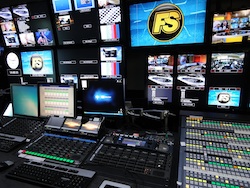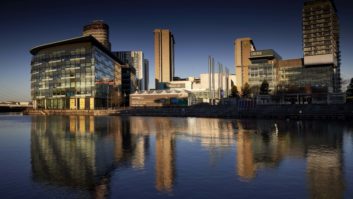
BBC’s Sports Production System at MediaCityUK is a fully integrated and centralised broadcast production infrastructure ready for a summer of sport. Adrian Pennington visited the broadcaster for a close look at the new systems.
BBC Sport is one of the main departments that has decamped to MediaCity in a staggered but fairly rapid migration that saw Football Focus move at the start of the 2011-12 soccer season, then Match of the Day (MOTD) in the autumn. Sports News went live in March and next up are the Euros next month, for which MediaCity will provide main studio presentation, before the Olympics.
The decision to relocate a chunk of BBC network operations to Salford was taken long before the announcement of London’s host win for 2012 but inevitably the timeframes have had to dovetail.
The multimedia galleries in the sports operation can handle 18 streams and up to 10 red button outputs simultaneously and will find optimal use during the Olympics where it will manage and feed 24 live HD streams to online platforms and cable and satellite providers.
“We’ve unlocked all the potential of HD output which could never have happened in London,” says BBC Sport’s Technical Executive Charlie Cope, who was responsible for the technical migration — enabling BBC Sport to remain on-air and for planning production workflows in the new building. “In London we had no crossover of core infrastructure such as our editing systems or ISDN lines between Radio 5 Live and BBC Sport, but the premise here is driven by shared operations.”
No duplication
The studio block (in a separate building and owned by Peel Holdings (Media)) features a high-end set used by Final Score and MOTD, which are mixed in Sport’s central production galleries so there’s no need to duplicate technology.
“Everything is designed to be reconfigured according to use and demand,” says Cope. “We can move playout into different areas, or different floors, or reset desks for graphics.”
Cope says the layout of the building itself brings together all the elements of Sport that used to be very disparate in TV Centre. Sports production is based on the ground and third floors, segmented by 5Live, the Corporation’s main sports radio station, with every operation closely integrated, while the open plan design encourages collaboration between different production teams.
The ground floor of Quay House contains two sets, one mainly used for Sports news and a second smaller set for drop-in presentations, world service or international feeds. “It’s easy for us to jack up a simple presentation space here and to take that content live,” says Cope.
Sports news teams work alongside text teams while radio production and senior editorial sit adjacent to ingest areas and galleries. “In the past, teams worked in siloed areas that prevented us from doing multimedia operations. This is all about trying to break that down. Technically I would say we are nearly there, although you are always looking ahead. The real challenge is getting the processes right and bringing people on board with the new workflows.”
For example, more coherent communication from planning to content delivery means more efficient use of resources such as sending one commentator to a venue to cover events for TV and radio where appropriate, or giving every member of the sports production team the contact details and features planning schedule of smaller teams at events overseas. The ability to self-operate browse and retrieval, video clipping and planning packages is key.
In theory an all-file based facility, inevitably not all of production will be tapeless. Aside from using freelance cameramen and footage from other broadcasters, BBC Sport archives 170,000 tapes in London — 12,000 of which have been digitised.
“We identified primary content which is now available (on nearline storage] for browse on desktops,” says Cope. “It doesn’t make financial sense to digitise it all and since the peak use of archive is up to two years after the event, in time the demand for tape will lessen. In terms of our own processes we are moving to a file-based production, archive and delivery system.
“Live is about 95% of our output so that drives our workflow choices,” he says. “The front-end tools we need to deliver live fast turnaround content are critical to maintaining the quality of our production aspirations on screen.”
Content access
From 4-5 different production systems at TV Centre there is now a single production system with single ingest for all sport (radio production is managed separately under the VCS system).
This Sports Production System (SPS) includes holding all content and associated metadata in centralised storage that can be accessed by users throughout the division. It gives all BBC Sport staff desktop access to content whereas before it was more of a bespoke post production system.
“The SPS is designed to allow 400 sports production teams and journalists to create more content of higher quality in a faster turnaround period,” says Cope.
The entire project had to be finalised in nine months to allow BBC Sport production to go on-air from December 2011. In this time, production and operational staff were trained in use of SPS which combines EVS’ production management systems with Harmonic nearline storage and Final Cut Pro editing. IPDirector provides a single interface for media management in all ingest and playout servers as well as nearline storage.
All live broadcast feeds from multiple competitions are ingested into XT3 and XS servers offering about 400 hours of live storage. The system can record up to 36 simultaneous live HD feeds encoded in ProRes422 QuickTime at 120 Mbps, complete with files imported from ENG crews using various card formats. The files are instantly available for browsing, editing or playout while an IP Ingest Scheduler offers a complete overview of incoming feeds.
All material is also automatically streamed onto a Harmonic MediaGrid with proxy files generated to nearline storage using timecode references.
The media management component of IPDirector further speeds up the process by allowing producers to place restrictions on what media is available to view – for example: editors working on a football package may only need to see football-related clips, making their search time quicker. Descriptive metadata are added to each clip at ingest and more information is added whenever a clip is used or modified, allowing a comprehensive history of each clip to be built for archive.
HD media recorded onto EVS systems in the studios is transferred to the MediaGrid, available to the post production team. Production teams and editors can search and review proxy media throughout the network using IPBrowse.
Review with Davina
A new web-based browsing interface solution called Davina is also available for most other BBC users to review content. Davina uses an IPDirector API to seek proxy files available in the MediaGrid and to retrieve any relevant metadata. Proxy files are re-transcoded and stored on a dedicated web storage system based on a Harmonic Rhozet server.
After media selection and clip compilation, the rough cut edit is displayed in a work in progress area of the central storage found in FCP online edit suites. Final Cut systems are connected directly to the MediaGrid storage for edit-in-place operations.
FCP editors can also find media created by producers or search and import media to FCP projects with the same metadata as producers. Once an edit is complete, a Final Cut Pro export plug-in sends it to the proper playout server and creates browsing copies for journalists and producers to review.
Using BBC News’ file exchange system (JEX) with the new production infrastructure, selected clips from the media storage via IPDirector can be sent or restored to/from any BBC News bureau or regional site.
Operators can drag and drop files, and integrate with the AP ENPS newsroom computer system (NRCS) to enable automated running order playouts in the Sport News gallery.
The BBC’s playout automation system, BigTed, is used in the gallery playout and controls EVS playout servers for rundown playlist operations. Based on the MOS support protocol of EVS’ content management systems, all final packages referred in the IPDirector database ready for airing, can be linked to the rundown playlist on the NCRS.
The playout operation can be entirely managed from the NRCS. Without that control, on-air operations can be managed using IPDirector’s playout schedule interface. In critical scenario situations, material can always be brought to air using LSM’s playlist remote controller as a backup tool.
“The SPS allows a complete overhaul of workflow production and technology which has transformed the volume and quality of what we can deliver,” says Cope. “The facility allows us to take all production into the HD and tapeless domain and to have capability for 5.1 audio delivery. It’s a bit of rollercoaster at the moment and we’ve had to hit the ground running. There’s been a lot of learning along the way and there’s plenty of evolution still to come.”







